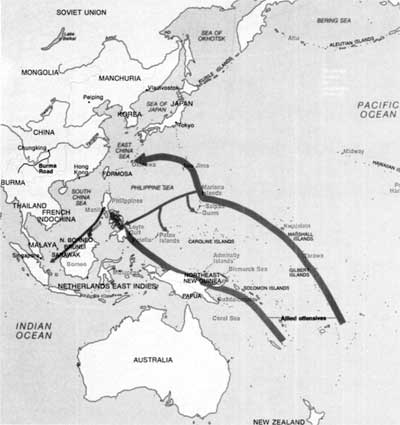|
War in the Pacific: The First Year
The Rising Sun
The Japanese invasion of colonial Asia and a number
of Pacific islands in the last month of 1941 expanded the frontiers of
her Greater East Asia Co-Prosperity Sphere, but also awoke a sleeping
nation, the United States. Despite remarkable Japanese successes in the
first six months of the war, Allied strategists (British Prime Minister
Winston Churchill and U.S. President Franklin D. Roosevelt) had decided
that the European theater of operations should be given top priority. It
was realized, however, that further Japanese expansion in the Pacific
must be contained, particularly in the southwest Pacific.

Map of the South Pacific. (click on image
for an enlargement in a new window)
|
Guam had been the first American territory seized by
Japanese Imperial Forces on December 10, 1941 Japan's next challenge to
the United States in the Pacific extended to the Philippine Islands. The
U.S. Navy successfully attacked Japanese bases in the Marshall Islands
in early February, 1942, but the great British base at Singapore fell to
the Japanese on 15 February, and the American-British-Dutch-Australian
naval forces were defeated at the Battle of the Java Sea on 27-28,
February. After a fierce, protracted campaign, much of Papua and New
Guinea, as well as the British-held Solomon Islands in the south Pacific
also surrendered to Japan's southern advancement. These islands were to
be used as a possible staging arena for attacks. In Asia, the British
colonies of Burma and India were eventual targets for inclusion into the
new Japanese order.

General Douglas McArthur was the supreme
allied commander for the Southwest Pacific Theater.
|

Admiral Chichi Naguno commanded
Japanese naval forces at Midway.
|
As Philippine Scouts and guerrillas bravely defended
the Philippines, native Solomon Islanders organized the coastwatchers,
to uncover Japanese plans behind enemy lines. Meanwhile, American
Lieutenant Colonel James Doolittle revolutionized aircraft-launched
bombing raids over Tokyo. This daring maneuver proved to be successful
one month later at the Battle of the Coral Sea, in May, 1942, changing
the course of the war. A series of Allied victories at Midway, the
Aleutian Islands, and in the jungles of New Guinea and Guadalcanal,
sealed the fate of a weakening nation.
Panic, hysteria, and fear, swept across America as
the war continued to expand. Roosevelt's War Relocation Authority was
established to administer the evacuation and internment of over 100,000
Japanese emigrants and American citizens of Japanese heritage in one of
America's darkest hours.
By determination, planning, and in some cases sheer
luck, the Allies managed to halt the Japanese advances. The greatest
extent of the Japanese expansion had been reached by early 1943; full
retreat or a frantic defense were the only available options of the
Imperial Forces.

Japanese troops raise the Imperial
battle flag on Kiska Island in the Aleutians on June 6, 1942. Japanese
forces were victorious in securing former Allied-controlled areas in
Asia and the Pacific during the first six-months of the Pacific Theater
of World War II. By the summer of 1942, Japanese advances were halted by
key Allied victories at Midway, Papua, and the Solomon Islands.
|

|